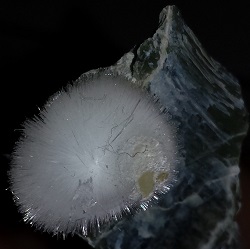A- |
B- |
C- |
D- |
E- |
F- |
G- |
H- |
I- |
J- |
K- |
L- |
M- |
N- |
O- |
P- |
Q- |
R- |
S- |
T- |
U- |
V- |
W- |
X- |
Y- |
Z |
ARTINITE:PHYSICAL CHARACTERISTICS:Color is white or colorless. Luster is silky to fibrous. Transparency crystals are transparent to translucent. Crystal System is monoclinic; 2/m Crystal Habits include radiating spherical aggregates of acicular to fibrous crystals. Hardness is 2.5 Specific Gravity is 2.0 (very light) Cleavage is perfect in one direction. Fracture is fibrous. Streak is white. Associated Minerals include serpentine, hydromagnesite, talc and olivine. Notable Occurrences include San Benito Co., California and Long Island, New York, USA and Campo Franscia, Lombardia, Italy. Best Field Indicators are crystal habits, color, associations, softness and density. Artinite is a somewhat rare carbonate mineral. It forms as a crust of acicular to fibrous crystal aggregates sometimes collected into tight perfectly spherical balls. It is always associated with ultra-basic igneous and metamorphic rocks such as serpentinite. It often surprises people when they are told that it is a carbonate mineral. It has the appearance of several silicate minerals and forms in a somewhat atypical carbonate environment. It has nearly the same habit as mesolite, pectolite, natrolite, okenite and gyrolite. However these minerals are not associated with the mineral serpentine like artinite. In fact a specimen of artinite without serpentine would be very unusual. The two minerals make for a nice association couple. They are popular and attractive with the snow white fibrous balls of artinite set upon the greasy lustered jade green serpentine base. |

